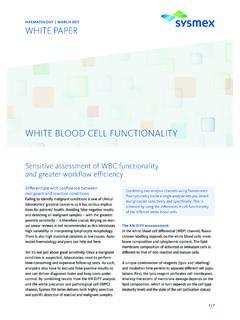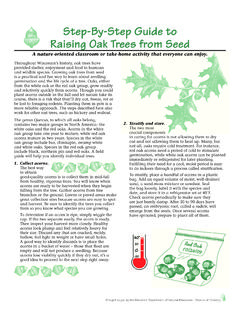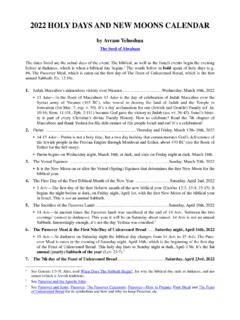Transcription of SEED Haematology – The role of the peripheral blood smear ...
1 seed Haematology Sysmex Educational Enhancement and Development February 2013. The role of the peripheral blood smear in the modern Haematology laboratory Automated Haematology cell counting The manual differential count is performed by the visual The laboratory practice of Haematology has evolved tre- examination of a stained blood smear using a light micro- mendously over the past few decades with automated ana- scope. A fresh, well-made, peripheral blood smear is crucial lyser generated complete blood counts (CBC) having fully for accurate cell morphology assessment. The components replaced the original manual individual parameter assay contributing towards the final result are fourfold: The qual- methods.
2 The traditional review of the automated data, and ity of the smear , the quality of the stain, the quality of the more specifically the white blood cell differential count, of microscope and the skill and experience of the microscopist. every sample analysed, by means of microscopic examina- tion of the peripheral blood smear has fallen away in most a) The making of blood smears laboratories. The reason for this is the enhanced precision The peripheral smear needs to be correctly made. Smears and accuracy of automated cell counting in comparison with are most commonly made using the spread or wedge . the traditional manual counting methods. Moreover, it is technique.
3 Manual smears are made by placing a drop of also recognised that the superiority of automated differential blood on one side of a glass slide, and spreading this by rap- cell counting is limited to well characterised mature white idly moving a second glass slide or spreader across the first blood cells, whereas manual microscopy is better for differ- slide at an angle. A well-made peripheral smear is thick (red entiating more immature and abnormal cells where nuances blood cells are overlapping) at the frosted end and becomes of cytological features are relied upon. In recognition of this, progressively thinner with good separation of cells toward over and above the quantitative data, analysers provide the opposite end.
4 The so-called zone of morphology , the qualitative information in the form of flags which alert the area of optimal thickness for light microscopic examination, operator to the possibility of erroneous results due to inter- should be at least 2 cm in length. The smear should occupy fering variables as well as the presence of abnormal cells. the central area of the slide and be margin-free at the edges. Based on this, only selective manual peripheral blood smear Producing a good quality smear requires practice. The blood review on the basis of abnormal quantitative data and flags smear must not be too thin or too thick and the tail of the is required.
5 Whilst the CBC data are accepted without ques- smear must be smooth. The perfect quality smear is influ- tion, it is still commonly a knee-jerk reaction in many insti- enced by three factors: speed, angle and drop size. tutions to automatically confirm the white blood cell differ- The faster the spreader slide is moved, the longer and ential by means of microscopic examination of a peripheral thinner the smear will be. The slower the slide is moved, blood smear . the shorter and thicker the slide will be. An angle greater than 30 makes the smear thicker;. The manual peripheral blood smear less than 30 the smear is thinner. Whilst the manual differential count is generally considered A small drop of blood may be insufficient to prepare to be superior to an analyser generated count for pathologi- a slide of sufficient length; too large a drop may cause cal samples, this only holds true under very strict conditions.
6 The smear to extend beyond the length of the slide. seed Haematology The role of the peripheral blood smear in the modern Haematology laboratory 2. Sysmex Educational Enhancement and Development | February 2013. The viscosity (haematocrit) of the blood , which can be Cellular Component Colour highly variable from patient to patient, will also affect the Nucleus Chromatin Purple smear . blood from a patient with anaemia will have a lower Nucleoli Light blue viscosity and the smear will be too thin if the angle is not Cytoplasm Red blood Cell Dark pink increased. The opposite holds true for blood from a patient Reticulocyte Grey-blue with polycythaemia. Lymphocyte Blue Monocyte Grey-blue Neutrophil Pink blood smears that are too thin or too thick present a prob- Eosinophil Pink Basophil Blue lem.
7 Extremely thin smears (caused by too small a drop, Granules Neutrophil (toxic Purple (dark blue). too slow spreading or too low a spreader angle), may result granulation). in red blood cells (RBC) that appear as spherocytes and in - Eosinophil Orange-red Basophil Purple-black creased white blood cells (WBC), such as monocytes and Platelet Purple neutrophils, in the tails. An incorrect differential will result. Inclusions Malaria parasite Purple In extremely thick smears, the counting area is too small. At least ten low-powered fields where fifty percent of the RBC Tab. 1 Cellular component colouration in response to Romanowsky staining (Adapted from Dacie and Lewis, Practical Haematology ) [1].
8 Do not overlap are required for an accurate WBC differen- tial. blood smears with excessive tails or gritty feathered ends indicate a spreader edge that is rough or dirty, or an i. How stains work accumulation of WBC due to either slow spreading or a The mechanism by which certain structural components very high WBC count. of a cell stain with a certain dye whereas other similar struc- tures do not, although staining with other dyes, depends on complex differences between dyes, how they interact with each other, as well as the pH of the stain and the a) cellular micro environment. Acidic structures pick up the basic dye, methylene blue, which as its name implies is blue in colour.
9 In contrast basic or alkaline structures bind acidic dyes, in this case eosin which is pink. An easy way b) to remember this is to consider the intense pink colour of the eosinophil granules, and the intense purple colour of the basophil granules. The term eosinophilic refers Fig. 1 a) Poor quality manual peripheral blood smear and b) Good to having a likeness or attraction to eosin (the pink dye). quality automated smear and basophilic to the basic or blue dye. b) The staining of the blood smear Methyl alcohol is used as both a solvent and fixative and The peripheral blood smear needs to be stained so that the forms part of the Romanowsky staining procedure.
10 Cytoplasmic and nuclear details of the various cell types are accentuated. Romanowsky stains or derivations thereof ii. Factors giving rise to faulty staining such as Wright, Wright-Giemsa and May-Gr nwald-Giemsa Many factors can give rise to a poorly stained slide. This are universally used in Haematology . may manifest as a slide that is either too dark or too pale, too blue or too pink, granules may appear too dark or are A Romanowsky stain is any stain combination consisting of absent, the background may appear blue or there may be eosin with methylene blue and/or any of its oxidation prod- stain deposits. Different cellular structures have different ucts.






